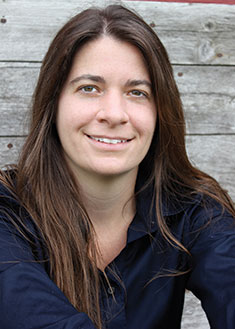The habitat in central Maryland where Jill Sisson Quinn ’97, English grew up isn’t very different from the habitat in central Wisconsin where she lives now. The birds, insects, and trees are similar; you can use the same field guides, she says. Yet when she moved to the Midwest in 2005, she had traded a place full of rivers for one full of lakes, and “it was a huge problem for me,” she says. “I would wake up in the middle of the night and I would feel like I was moving to another planet.”
Is this homesickness, or an acute sensitivity to one’s environment? Quinn’s work suggests that the two things tangle like roots from different plants, complicating where personal experience starts and human nature begins. The essays in her 2010 collection, Deranged: Finding a Sense of Place in the Landscape and in the Lifespan, are remarkable literary hybrids designed to explore these complications. In one piece, she weaves a discussion of Lucy, the 3.2-million-year-old skeleton of a human ancestor, alongside a remembrance of Fatso, a tree near her childhood home. In another, a breakup is a launchpad for thinking about shrinking forests, and how life at their edges is different than their interiors.
The shifting definition of place is a constant in Deranged, and she refers often to her childhood home – more precisely, the branches of the Patapsco River not far from it. As she writes in the book’s introduction, “I like to believe that there is some un-faulty guide steering me home, and hope that if I am not there now, I soon will be.”
Quinn has been publishing these lyric essays since 2001, but their sensibility is predated by the interest in science and literature she cultivated as a student. When she arrived at UMBC, she was committed to writing poetry, inspired in part by what she had learned about astronomy.
“I remember reading the textbook religiously,” she says. “I remember it talking about stars and the birth and death of stars, and how stars aren’t really alive but that we owe our existence to stars, because the atoms that make up our bodies were formed in the centers of stars. I never read a textbook that personified things and gave this eminence to them. That really moved me.”
She wrote her honors thesis on the work of Heather McHugh, a poet who draws heavily on nature. “She’s always been an environmental writer,” says James C. McKusick, her thesis advisor, who is now dean of the Davidson Honors College at the University of Montana. “Both in her prose and her poetry, she reflects deeply on people’s relationships with place, or with humankind’s relationship with the natural world. She reflects on that in a way that a poet should, with a lot of concrete imagery – a lot of deeply thought and felt images.”
Quinn’s writing process involves a lot of walking – 6.7 miles every day with her dog, to be exact – and a lot of thinking about connections: “I discover something in nature that’s weird, like a wasp, or these beautiful rocks, and I’ve got this question in my head. I know I’m going to connect them, and then I research the nature, and the connection grows out of that.”
Last year Quinn received a $30,000 Rona Jaffe Foundation Writers’ Award, given annually to emerging women writers. The prize has allowed her to take a half-time sabbatical from her job as a high-school English teacher. She’s currently at work on her second book, titled The Doctrine of Signatures, which leverages her close study of nature to address larger spiritual questions. This is perhaps an unlikely pursuit for a nature writer, who’s generally expected to be a John McPhee-like rover. But in Quinn’s particular line of work, depth trumps breadth.
“I’m not a traveler,” she says. “I don’t think I’ll ever exhaust Wisconsin or Maryland.”
– Mark Athitakis
For more about Jill Sisson Quinn and her work visit http://www.jillsissonquinn.com/
Tags: English, Winter 2014

